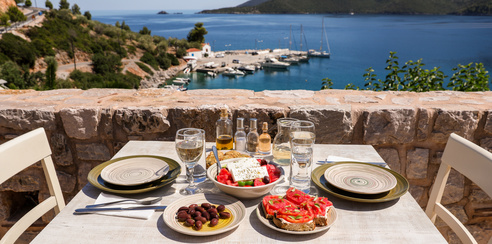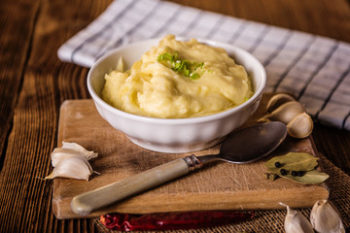The problem with authentic Greek cooking (apart from the fact you can’t stop eating it!) is that the recipes are so deceptively simple few people ever want to try them out in their own kitchens. After all, you might ask, how can 3 ingredients deliver up anything remotely delicious? However, unless you’ve and cooked and eaten with Greek village locals, it’s difficult to explain how simplicity is usually the best way to reach food-heaven – so you’re just going to have to trust me!

Scorthalia
This creamy-smooth potato sauce, full to the brim with garlic, and oozing extra virgin olive oil, is one of the most traditional dishes in all of Greek cooking. Greek Independence Day would be nothing without scorthalia served alongside boiled salt cod and a glass of retsina, and without it, what would Greek village women carry to their friends’ homes as a gift?

To make scorthalia in your own home, boil 3 large, floury potatoes in their skins until tender (Agria is the perfect potato variety for this dish). When cool, peel off the skins and discard. Mash the potato thoroughly with a masher (never use a kitchen blender or the sauce will turn gluey). When the potato is thoroughly pulverised, add enough pure virgin olive oil to it (nothing but the best oil or you’ll be disappointed) to bring the mixture to a spoonable (not runny) consistency. Next, add 2-3 (or more if you love garlic) finely chopped cloves of garlic. Stir it into the potato and oil mixture along with salt to taste (never add pepper), and press everything through a coarse sieve. Pile the ingredients into a container, cover, and leave to sit for several hours (or, better still the next day). Serve at room temperature (with a drizzle of olive oil poured over the top) as an exotic accompaniment to battered fish instead of chips. Congratulations – you’re cooking like a Greek.
Fava (not to be confused with fava [broad] beans)
Hold onto your hats because it just doesn’t get any easier (or delicious) than this lentil based appetiser-come-dip. Originating from the Island of Santorini (although Greeks from other regions will often argue the point!) fava is most popular in winter even though it is served at room temperature.
 To make fava, boil half a kilo of yellow split peas in salted water until very tender (almost at the mushy stage). Remove any froth from the top of the water with a slotted spoon, drain well and leave to cool until luke warm. Tip the cooked split peas into a food processor along with the juice of 3 large lemons and finely ground black pepper and salt to taste (use commercially ground pepper rather than that which you would normally grind at home – such subtleties really do make a difference). Blend until creamy-smooth.
To make fava, boil half a kilo of yellow split peas in salted water until very tender (almost at the mushy stage). Remove any froth from the top of the water with a slotted spoon, drain well and leave to cool until luke warm. Tip the cooked split peas into a food processor along with the juice of 3 large lemons and finely ground black pepper and salt to taste (use commercially ground pepper rather than that which you would normally grind at home – such subtleties really do make a difference). Blend until creamy-smooth.
The way you serve fava makes it what it is and gives it its authenticity. Spoon the creamed peas into desert-sized dishes, mound up and smooth with the back of a spoon. Next, flood the perimeter of the mound with pure virgin olive oil to a depth of about 1cm. Chop (but not too finely) half a red onion and scatter it on top (not down the sides) of the mound of peas. Stab a fat, pitted black olive (it must be Greek and not Spanish) into the very top of the mound and drizzle a little more olive oil over the onion so it runs down the side of the peas.
Eat your fava with crusty white country bread. If you can locate retsina (the resiny white wine traditionally served with this rustic fare), pour yourself a glass to go with it!










Join the Discussion
Type out your comment here:
You must be logged in to post a comment.